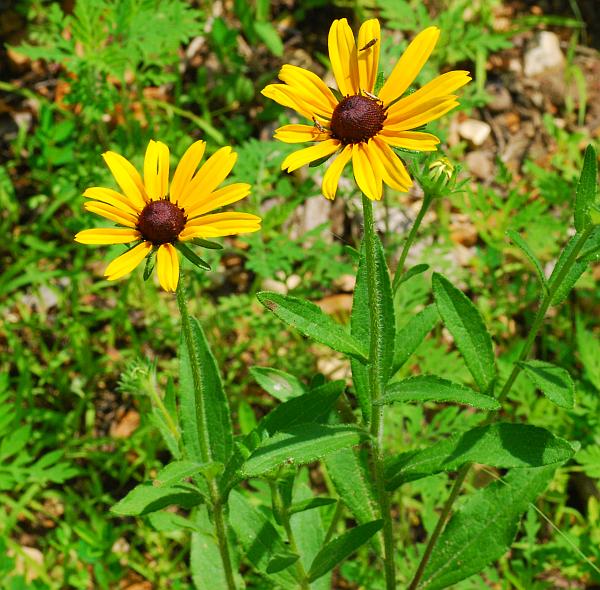Rudbeckia hirta L.
Black-Eyed Susan

Native
CC = 1
CW = 3
MOC = 96
© SRTurner
Rudbeckia hirta L.Black-Eyed Susan | |
 |
Native CC = 1 CW = 3 MOC = 96 |
© SRTurner |
|
Family - Asteraceae/Heliantheae Habit - Annual forb, sometimes resprouting the second year, usually with taproots but sometimes with only fibrous roots. Stems - Ascending to erect, to 1 m, multiple from base, scabrous, sparsely to densely pubescent with short, spreading to ascending hairs, not glaucous.
Leaves - Alternate, all unlobed, tapered or angled (lower leaves) to rounded or truncate (upper leaves) at the base, mostly inconspicuously wrapping around the stem, the upper leaves sometimes more conspicuously clasping the stem, the margins entire or sometimes with widely spaced, usually fine, sharp teeth, the surfaces sparsely to moderately hairy with spreading to loosely ascending, often minutely pustular-based hairs, usually slightly to moderately roughened to the touch, green when fresh. Basal and lowermost stem leaves sometimes present at flowering, mostly with a long, often winged petiole, the blade 5-30 cm long, 5-30 mm wide, mostly oblanceolate to elliptic, rounded or angled to a bluntly pointed tip. Median and upper stem leaves sessile or with a short, winged petiole, the blade 2-20 cm long, 3-40 mm wide, lanceolate to elliptic to ovate, angled or tapered to a bluntly or sharply pointed tip.
Inflorescence - Solitary heads or more commonly appearing as loose, open clusters. Heads - Involucral bracts 12-20, 8-30 mm long, lanceolate to linear, the outer surface moderately to densely hairy, the margins usually with moderate to dense spreading hairs. Receptacle 10-22 mm long, 10-20 mm in diameter, hemispherical at the start of flowering, later elongating and often becoming ovoid. Chaffy bracts subtending only the disc florets, shorter than to nearly as long as the disc florets (including the corolla), mostly angled to a triangular, sharply pointed tip, the outer surface glabrous or with short, stiff hairs toward the tip, the margins with a relatively long fringe of spreading, bristly hairs toward the tip, the very tip with 1 or less commonly 2 bristles.
Florets - Ray florets 8-21, sterile, the corolla 15-40 mm long, relatively slender, spreading to somewhat drooping at flowering, yellow to orangish yellow, sometimes the basal portion reddish-or purplish-tinged, the outer surface sparsely to densely short-hairy (especially toward the tip) and usually also minutely gland-dotted. Disc florets numerous, perfect, the corolla 3.0-4.5 mm long, greenish yellow to nearly white toward the base, dark purple to purplish brown toward the tip, the lobes ascending to spreading at flowering. Stigma lobes elongate and more or less sharply pointed at the tip. Pappus absent.
Fruits - Achenes 1.5-3.0 mm long, 4-angled, brown to black. Flowering - May - October. Habitat - Bases of bluffs, upland forest openings, upland prairies, glades, pastures, fields, railroads, roadsides, and open, disturbed areas. Frequently cultivated. Origin - Native to the U.S. Lookalikes - Other species of Rudbeckia, especially R. triloba and R. fulgida; more broadly, a number of other aster family plants. Other info. - This hardy plant is extremely popular in cultivation and is very common in the wild. It occurs naturally across Missouri and the eastern half of the continental U.S. It is recognized by its large yellow flower heads with dark centers, and the coarse hairiness of its foliage. Its most common lookalike is R. triloba, which differs in having some leaves which are lobed. However, the lobing is highly variable and sometimes absent, and thus not a reliable differentiator. R. triloba also has smaller, more numerous flower heads and a more branched habit, and is later blooming. R. fulgida has much broader leaves and typically grows in wetter places. Photographs taken at Shaw Nature Reserve, Franklin County, MO, 5-29-2007 and 6-12-2007, and Little Lost Creek Conservation Area, Warren County, MO, 6-9-2017 (SRTurner). |